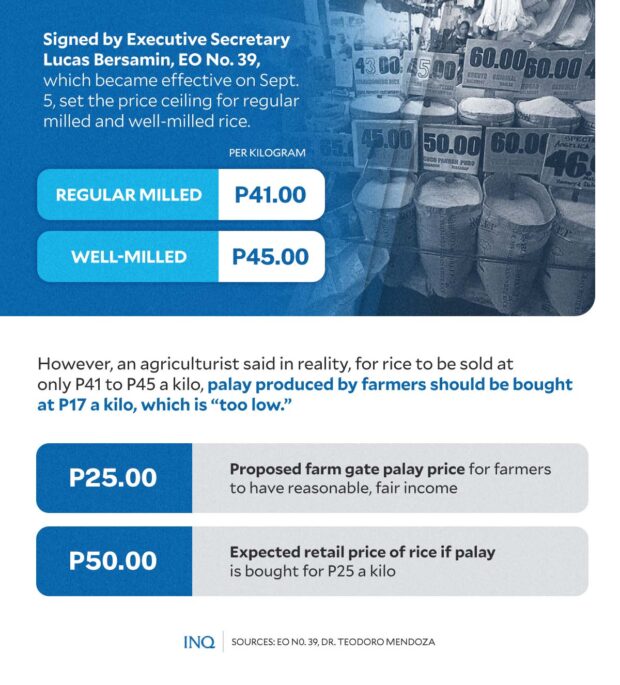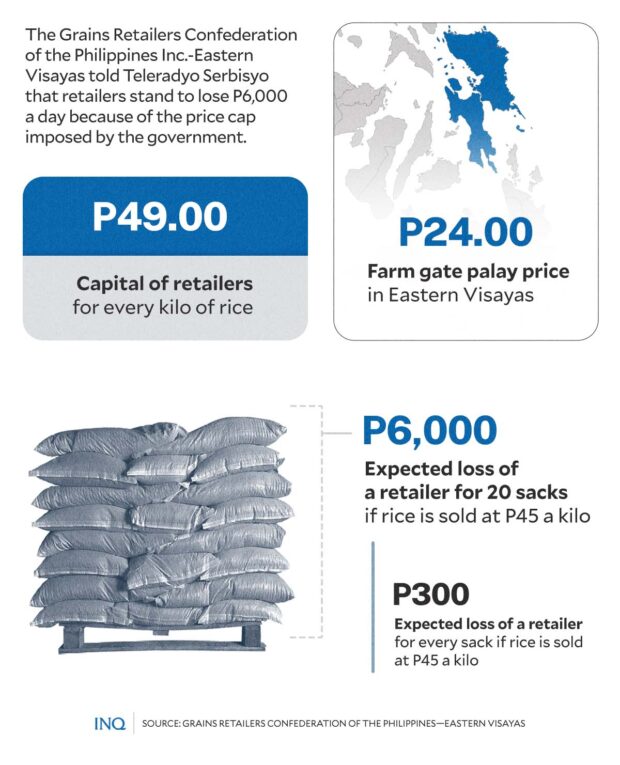Double-edged sword: The costs of controlling rice prices
MANILA, Philippines—The “era of cheap food is over,” but President Ferdinand Marcos Jr. promised to bring down the price of rice to only P20 a kilo. “We are doing everything we can,” he said.
READ: Bongbong Marcos on P20/kg rice: ‘We’re not there yet, but we’re doing everything we can’
However, the price of a kilo of rice spiked and hit an all-time high last month, with local commercial rice costing P42 to P55 (regular milled) and P47 to P56 (well-milled) on Aug. 31.
Because of this, the government imposed a mandated price ceiling on rice all over the Philippines to ensure that the grain will be “reasonably priced and conveniently accessible to Filipinos.”
Signed by Executive Secretary Lucas Bersamin, Executive Order (EO) No. 39, which took effect on Sept. 5, set the price cap for regular milled and well-milled rice to P41 and P45.
As pointed out by the National Economic and Development Authority (Neda), the implementation of the price ceiling will not only reduce rice prices but will also penalize and discourage hoarding.
Article continues after this advertisementHowever, EO No. 39 does not come without a cost.
Article continues after this advertisementRetailers to bleed out
With the price cap, local grain retailers stressed they could lose P6,000 a day, with the Grains Retailers Confederation of the Philippines-Eastern Visayas saying they project nothing but losses.
Frederic Dy, president of the group, told Teleradyo Serbisyo that retailers bought their stock at a high price, but they are expected to sell those at only P41 to P45 a kilo.
He did the math, pointing out that with palay being bought at P24 a kilo, their capital for a kilo of rice is already at P49, so if they sell well-milled rice for only P45, they stand to lose P4 a kilo.
RELATED STORY: Price cap on rice might hurt small retailers, Makabayan bloc says
The P4, he said, would mean that a retailer, who sold a sack of the grain, will lose P300, and then P6,000 for 20 sacks which, Dy said, is the average volume sold a day.
He stressed that the government should consider them, too, saying that they also have to pay for plastic packaging and rent for their stalls.
Business groups already asked the government to limit the implementation of EO No. 39 to only two to three weeks, warning that prolonging such a regulation could bankrupt small retailers.
READ: Biz group urges lifting of rice price cap after 2 to 3 weeks
Farmers ‘not safe from harm’
Dr. Teodoro Mendoza, a retired professor of crop science at the University of the Philippines Los Baños, told INQUIRER.net that “the government should let the market forces decide.”
This, as he explained that for rice to be sold at P41 to P45 a kilo without hurting retailers, palay should be bought from farmers at P15 to P17 a kilo.
However, bringing down the farm gate palay price to this low will not be fair for farmers, who are already sinking deeper in poverty because of the meager income they get from their harvest.
Mendoza previously proposed that palay should be bought at P25 a kilo so that farmers can have “fair and reasonable” income, which should be enough to provide for the needs of their families and rice lands.
The P25, he said, would only translate to P50 a kilo of rice.
He pointed out that the cost of production is getting higher, and farmers should get enough income so that they will not be discouraged from tilling their rice lands.
Gov’t solution
Addressing criticisms against EO No. 39, the House of Representatives said it will earmark P2 billion to assist retailers affected by the price ceiling.
The Department of Social Welfare and Development said small retailers will get a maximum subsidy of P15,000 to cover the losses they are expected to incur with the imposition of the price cap.
READ: Rice retailers say compliance with price cap OK for at least a week pending gov’t aid
However, Mendoza said the P2 billion is too low compared to the actual value of lost sales by retailers for 30 days—P5.85 billion. He stressed the P2 billion is only 34 percent of that amount.
“We also understand the difficulties of distributing ayuda aside from the fact that it is only a fraction of the total lost sales if EO No. 39 will be implemented for about a month,” he said.
Mendoza pointed out: “What if the implementation [of EO No. 39] exceeds more than a month? Will there be a continuing [provision] of ayuda?”
RELATED STORY: President’s price cap on rice seemed to have an effect on world market, says Speaker
‘RTL failed’
As stressed by the Integrated Rural Development Foundation (IRDF) “this is the opportune time for the government to subsidize the rice program and the rolling stores.”
“The EO [No. 39] will not solve the problem unless the government intervenes by physically putting cheap rice in the market,” it said.
The government should instead send rolling stores to communities and sell rice through the National Food Authority (NFA) or cooperatives at a cheaper price.
This, however, is a function that has to be reinstated to the NFA by repealing the Rice Trade Liberalization Act, which was signed by then President Rodrigo Duterte in 2019 and opened the floodgates to imported rice.
Arze Glipo, IRDF executive director, said “by eliminating government hand in stabilizing price and supply, by reducing NFA to mere stockpiling of rice supply good only for 15 days, by prioritizing the interests of big business both importers and banks, the people especially the working masses who subsist on meager wages and incomes are now paying the cost of this failed policy.”
IRDF said Congress has to act fast, review and repeal the Duterte-era law, allocate emergency funds for procurement of palay at the minimum of P22 a kilo for NFA to procure at least 10 percent of total palay production this coming harvest.
The government, it said, should ink contracts with private millers to lend their dryers since NFA’s drying facilities are all gone if not dilapidated, mobilize warehouses of local governments and ensure in the next three months that government warehouses have stockpiled rice supply good for 60 days minimum.



